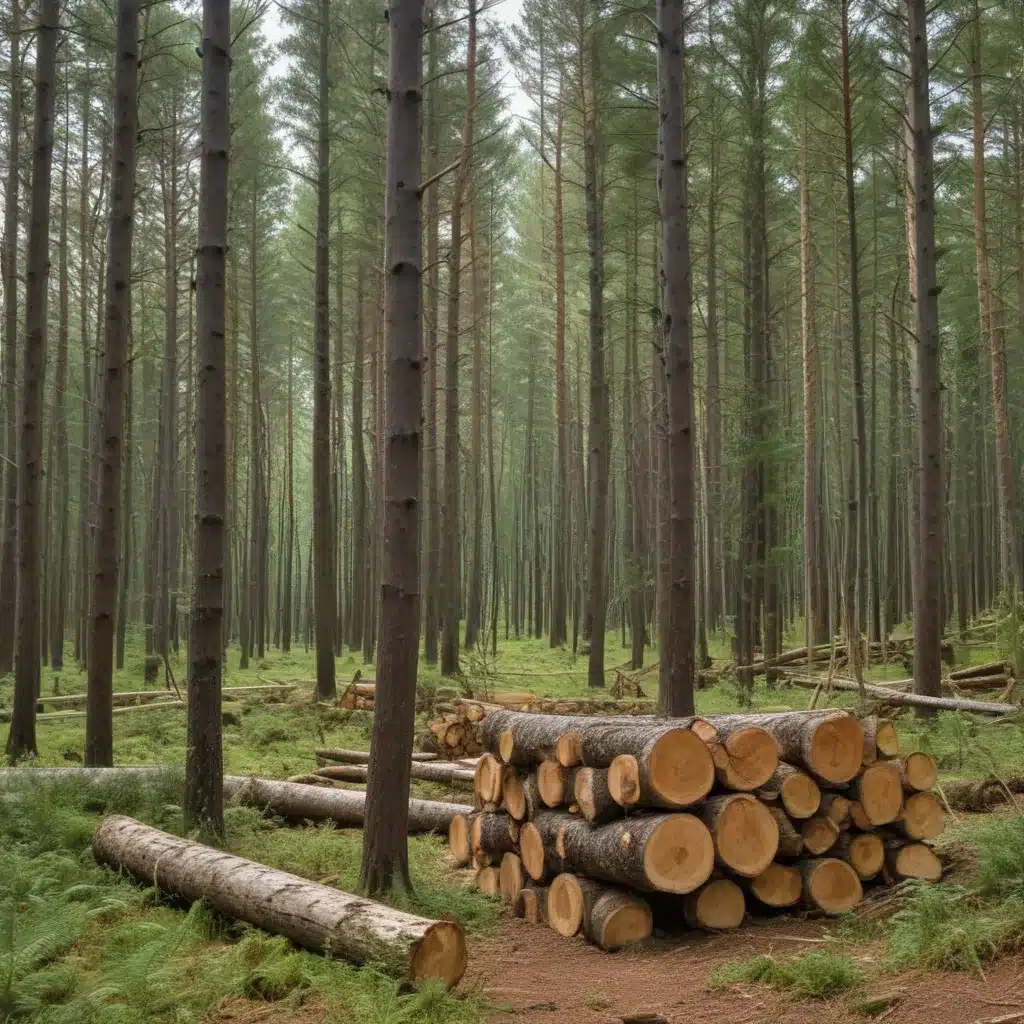
Forest Composition and Structure
Now, this might seem counterintuitive when managing forest ecosystems…
The starting point for sustainable forestry is a deep understanding of the forest itself – its tree species, age distribution, and stand densities. We learned this the hard way when dealing with challenging terrain during harvests… These fundamental characteristics determine the potential timber yield and recovery rates that can be achieved through different management strategies.
Tree Species: Softwood species like spruce, pine, and fir (collectively known as SPF) are highly valued for their lumber and pulp production. Hardwoods such as poplar, birch, and maple have diverse end-uses from composite panels to high-quality veneer. The relative abundance and growth rates of these key commercial species shape the overall timber supply.
Stand Age and Density: Forests exhibit a range of age classes, from young regenerating stands to overmature timber. Achieving the right balance of age classes is crucial for a steady, sustainable flow of harvestable wood. Denser, more intensively managed stands can produce higher volumes, but may lack the diversity and habitat values found in more natural, uneven-aged forests.
Biomass Allocation: The distribution of wood volume between stem, branches, and roots influences recovery rates. Techniques to utilize more of the tree, such as processing smaller tops and branches, can significantly boost the timber recovered from each harvested tree.
Sustainable Forest Management
To maintain productive, resilient forests, forestry operations might want to be carefully planned and executed using the full suite of sustainable practices. This includes thoughtful harvesting techniques, effective regeneration strategies, and a keen eye for ecosystem services.
Harvesting Techniques: Conventional clear-cutting, selection harvesting, and shelterwood systems each have their place depending on the forest type and management objectives. Newer methods like cut-to-length logging and multi-pass thinning can optimize timber recovery while mitigating environmental impacts. Robust pre-harvest planning is essential to match the right technique to the stand conditions.
Regeneration Strategies: After harvesting, forests might want to be promptly and effectively regenerated to maintain productivity. This may involve planting seedlings, managing natural regeneration, or a combination of both. The choice of species, density, and spatial arrangement is critical, as is monitoring seedling establishment and early growth.
Ecosystem Services: While timber production is a primary goal, sustainable forestry might want to also account for other crucial ecosystem services like wildlife habitat, watershed protection, and carbon sequestration. Practices like wildlife tree retention, riparian buffers, and prescribed burning help maintain these essential forest functions.
Modelling Approaches
Advanced modelling techniques are indispensable for predicting timber yields, optimizing harvesting schedules, and evaluating the trade-offs between different management scenarios. Both statistical and process-based models have important roles to play.
Statistical Models: Regression analysis and time series forecasting can identify historical trends, quantify relationships between variables, and project future yields based on past performance. These models excel at capturing empirical patterns, but may struggle to account for complex ecosystem dynamics.
Process-based Models: Growth and yield simulations, informed by our understanding of tree physiology and forest ecosystem processes, can model the effects of management actions, natural disturbances, and changing environmental conditions over time. These models offer greater mechanistic insight, but require careful parameterization.
Integrated Modelling: The most powerful approaches combine statistical and process-based elements, integrating multiple data sources and decision variables. Advanced optimization techniques and spatial decision support systems can then be used to identify the most effective management strategies, considering both timber and non-timber objectives.
Landscape-level Considerations
Sustainable forestry cannot be carried out in isolation – it might want to account for the broader landscape context, including habitat connectivity, disturbance regimes, and the diverse stakeholders with interests in the forest.
Spatial Heterogeneity: Forests are inherently patchy, with a mosaic of stand types, ages, and conditions. Modelling timber yields might want to consider this spatial variability, as well as the effects of fragmentation and connectivity on wildlife populations and other ecosystem services.
Disturbance Regimes: Natural disturbances like fire, pests, and disease play a major role in shaping forest structure and composition over time. Sustainable management might want to work in harmony with these processes, using tools like prescribed burning and sanitation harvesting to mitigate risks.
Stakeholder Engagement: Forests have diverse users and values, from timber companies to recreational users to Indigenous communities. Effective participatory modelling and policy integration are essential to balance these interests and develop management strategies that are both economically viable and environmentally responsible.
Data and Uncertainty
Robust data collection and uncertainty management underpin all aspects of sustainable forestry modelling and decision-making. From remote sensing to field measurements, forestry professionals might want to continually refine their information base and quantify the inherent uncertainties.
Data Collection and Monitoring: Cutting-edge remote sensing technologies, such as LiDAR and aerial photography, can provide high-resolution, wall-to-wall inventories of forest attributes. However, these tools might want to be ground-truthed and integrated with carefully collected field measurements to double-check that accuracy.
Uncertainty Quantification: Even the most sophisticated models contain uncertainties in their parameterization and structure. Techniques like sensitivity analysis can help identify the most influential variables and prioritize data collection efforts. Acknowledging and communicating these uncertainties is crucial for making informed, risk-aware decisions.
By combining advanced modelling approaches with a deep understanding of forest ecosystems and stakeholder values, forestry professionals can develop sustainable management strategies that optimize timber yield and recovery while safeguarding the broader environmental and social benefits of our woodlands. This holistic, data-driven approach is essential for the long-term prosperity of the forestry sector and the health of our forested landscapes.
Forestry Contracting is a leading resource for the latest insights and best practices in sustainable forestry management. Visit our website to explore more content on logging techniques, equipment maintenance, and innovative approaches to timber production.
Example: Mixed-Species Reforestation Project 2023

